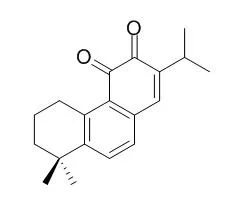| Description: |
Miltirone is a CYPs inhibition, it has been characterized as a low-affinity ligand for central benzodiazepine receptors, it might ameliorate the symptoms associated with discontinuation of long-term administration of ethanol or of other positive modulators of the GABA A receptor. Miltirone possesses significant anticancer, antibacterial, antioxidant, and anti-inflammatory activities, the hepatocyte metabolism is the major route of clearance for miltirone. Miltirone is collateral sensitive in multidrug-resistant P-gp-overexpressing cells, induces G2/M arrest, and triggeres apoptosis via ROS-generated breakdown of MMP and DNA damage. Miltirone has antiprotozoal activity against T. brucei rhodesiense STIB 900.
|
| Targets: |
P-gp | PARP | ROS | IkB | MMP(e.g.TIMP) | p21 | P450 (e.g. CYP17) | GABA Receptor | Calcium Channel | Bcl-2/Bax | Antifection | IKK |
| In vitro: |
| J Nat Prod. 2015 Jun 26;78(6):1339-47. | | Miltirone Induces G2/M Cell Cycle Arrest and Apoptosis in CCRF-CEM Acute Lymphoblastic Leukemia Cells.[Pubmed: 26035463] | Miltirone (1) is a diterpene quinone extracted from a well-known Chinese traditional herb (Salvia miltiorrhiza). We investigated the cytotoxic effects of Miltirone toward sensitive and multidrug-resistant acute lymphoblastic leukemia cell lines.
METHODS AND RESULTS:
Miltirone inhibited multidrug-resistant P-glycoprotein (P-gp)-overexpressing CEM/ADR5000 cells better than drug-sensitive CCRF-CEM wild-type cells, a phenomenon termed collateral sensitivity. Flow cytometric analyses revealed that Miltirone induced G2/M arrest and apoptosis. Furthermore, Miltirone stimulated reactive oxygen species (ROS) generation and mitochondrial membrane potential (MMP) disruption, which in turn induced DNA damage and activation of caspases and poly ADP-ribose polymerase (PARP). Downregulation of CCNB1 (cyclin B1) and CDC2 mRNA and upregulation of CDKN1A (p21) mRNA were in accord with Miltirone-induced G2/M arrest. Moreover, Miltirone decreased cell adherence to fibronectin. Molecular docking revealed that Miltirone bound to the ATP-binding site of IKK-β.
CONCLUSIONS:
In conclusion, Miltirone was collateral sensitive in multidrug-resistant P-gp-overexpressing cells, induced G2/M arrest, and triggered apoptosis via ROS-generated breakdown of MMP and DNA damage. Therefore, Miltirone may be a promising candidate for cancer chemotherapy. | | Planta Med. 2011 Sep;77(14):1594-6. | | Antiplasmodial and antitrypanosomal activity of tanshinone-type diterpenoids from Salvia miltiorrhiza.[Pubmed: 21412700 ] | In a medium throughput screen of 880 plant and fungal extracts for antiprotozoal activity, a dichloromethane extract of Salvia miltiorrhiza roots was active against both Trypanosoma brucei rhodesiense and Plasmodium falciparum.
METHODS AND RESULTS:
With HPLC-based activity profiling in combination with on- and off-line spectroscopic methods (PDA, -MS (n), HR-MS, microprobe NMR), the active compounds were identified as tanshinone-type diterpenoids. Subsequent isolation and structure elucidation yielded the known substances Miltirone (1), tanshinone II a (2), 1,2 dihydrotanshinquinone (3), methylenetanshinquinone (4), 1-oxoMiltirone (5), 11-hydroxymiltiodiol (6), tanshinone I (7), methyltanshinonate (8), and cryptotanshinone (9). The IC₅₀s of the compounds were determined against the two parasites and rat myoblast (L6) cells.
They ranged from 4.1 μM to over 30 μM against P. falciparum K1 strain with selectivity indices (SI) from 0.3 to 1.9. IC₅₀s against T. brucei rhodesiense STIB 900 were from 0.5 μM (1, 4) to over 30 μM, and 4 showed the greatest selective activity with an SI of 24. |
|
| In vivo: |
| Alcohol Clin Exp Res. 2006 May;30(5):754-62. | | Identification of miltirone as active ingredient of Salvia miltiorrhiza responsible for the reducing effect of root extracts on alcohol intake in rats.[Pubmed: 16634843] | Previous work found that extracts from the roots of Salvia miltiorrhiza, a Chinese medicinal herb, reduced alcohol intake in selectively bred Sardinian alcohol-preferring (sP) rats. The present study was designed to evaluate whether Miltirone, one of the possible active constituents of S. miltiorrhiza, might be responsible for the reducing effect of the extracts on alcohol intake.
METHODS AND RESULTS:
An initial experiment assessed the effect of 100 mg/kg (intragastric, i.g.) of 4 extracts of S. miltiorrhiza, differing in Miltirone content (0, 2, 3, and 7%, respectively), on alcohol intake in alcohol-experienced sP rats exposed to the 2-bottle "alcohol (10%, volume in volume) versus water" choice regimen. Subsequently, the effect of pure Miltirone (2.5-10 mg/kg, i.g., i.e., a dose range comparable to its content in the effective doses of the active extracts) on acquisition and maintenance of alcohol-drinking behavior was evaluated in alcohol-naive and alcohol-experienced sP rats exposed to the 2-bottle choice regimen. The effect of Miltirone (10 mg/kg, i.g.) on blood alcohol levels was assessed after the i.g. and intraperitoneal (i.p.) administration of alcohol. Finally, the effect of Miltirone (30-100 mg/kg, i.g.) on the severity of alcohol withdrawal syndrome was evaluated in Wistar rats made physically dependent on alcohol by the repeated administration of intoxicating doses of alcohol.
The reducing effect of 4 different extracts of S. miltiorrhiza on alcohol intake was positively and significantly correlated with their Miltirone content. Pure Miltirone reduced alcohol intake in alcohol-experienced rats and delayed acquisition of alcohol-drinking behavior in alcohol-naive rats. Similar to S. miltiorrhiza extracts, Miltirone markedly reduced blood alcohol levels when alcohol was administered i.g. but not i.p., suggesting that Miltirone hampered alcohol absorption from the gastrointestinal system. Finally, Miltirone failed to affect the severity of alcohol withdrawal syndrome in alcohol-dependent rats.
CONCLUSIONS:
The results of the present study suggest that Miltirone is the likely active constituent of S. miltiorrhiza responsible for the reducing effect of its extracts on alcohol intake in different experimental models of excessive alcohol consumption. |
|






 Cell. 2018 Jan 11;172(1-2):249-261.e12. doi: 10.1016/j.cell.2017.12.019.IF=36.216(2019)
Cell. 2018 Jan 11;172(1-2):249-261.e12. doi: 10.1016/j.cell.2017.12.019.IF=36.216(2019) Cell Metab. 2020 Mar 3;31(3):534-548.e5. doi: 10.1016/j.cmet.2020.01.002.IF=22.415(2019)
Cell Metab. 2020 Mar 3;31(3):534-548.e5. doi: 10.1016/j.cmet.2020.01.002.IF=22.415(2019) Mol Cell. 2017 Nov 16;68(4):673-685.e6. doi: 10.1016/j.molcel.2017.10.022.IF=14.548(2019)
Mol Cell. 2017 Nov 16;68(4):673-685.e6. doi: 10.1016/j.molcel.2017.10.022.IF=14.548(2019)